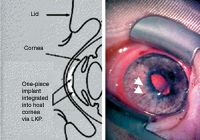Article
Tissue-engineered cornea for refractive correction, transplantation may be reality
Washington, DC—Researchers focusing on developing a tissue-engineered (TE) cornea for use in transplantation or refractive correction have made significant progress, although a number of challenges still lie ahead, said May Griffith, PhD, at World Cornea Congress V.
Washington, DC-Researchers focusing on developing a tissue-engineered (TE) cornea for use in transplantation or refractive correction have made significant progress, although a number of challenges still lie ahead, said May Griffith, PhD, at World Cornea Congress V.

"So far, implants have been developed that emulate the largely collagenous extracellular matrix composition of human corneas, and that have dem-onstrated good performance over periods of up to 6 months in animals," Dr. Griffith said.
Mimic human properties Designers of a TE cornea are aiming to mimic all of the properties of the human cornea in order to produce a product that offers transparency, suturability, and acts as a tough barrier against infection and injury. In addition, it must be biocompatible, and it should integrate seamlessly into host tissue while being able to promote repair and regeneration of the host cornea.
"Implanting a replacement that achieves host regeneration rather than using a prosthesis has several advantages because full integration with the host tissue could offer a lifetime without risk of rejection or need for immunosuppressive drugs," Dr. Griffith noted.
In creating a TE cornea, Dr. Griffith and colleagues have been using natural materials (collagen) that are present within the human cornea matrix to replace the scaffolding of the damaged or diseased cornea and adding synthetic materials for reinforcement along with bioactive factors, such as cytokines and growth factors, to enable host integration. The cellular components of the cor-nea are expected to come from the host or to be jump started with stem cells if necessary.
"The cornea is mostly composed of extracellular matrix and cells, and although the extracellular matrix is very complex, in the dish we have distilled it down to the lowest common denominator and are focusing on use of type I collagen, which composes the bulk of the stroma," Dr. Griffith said. "The premise for using materials taken from the extracellular matrix is that molecules that have directed organ development will likely contribute to wound healing and regeneration."
Because type I collagen would be easily degraded, a biosynthetic hybrid polymer has been developed using collagen plus synthetic molecules that crosslink the material and reduce sites for attack by de-gradatory enzymes. Unlike collagen alone, which is translucent and mechanically weak, the biosynthetic polymer TE cornea is optically clear and adequately robust for suturing.
Moreover, specialized properties can be conferred through the grafting of bioactive peptides, Dr. Griffith said.
"Compared with the human corneal matrix, TE corneal implants have been created that have almost the same refractive index and offer identical transmission and backscatter properties," Dr. Griffith explained. "These materials exhibit glucose permeability, can be ablated with the excimer laser, are biocompatible, support wound healing and regeneration, and, thanks to the addition of bioactive peptides, can offer the opportunity for more rapid re-innervation compared with the human cornea."
Synthetic biomimetic materials are also being developed for patients with conditions where cells are not available, regeneration is not possible, or there is a high risk for immune reaction to proteins.
Newsletter
Don’t miss out—get Ophthalmology Times updates on the latest clinical advancements and expert interviews, straight to your inbox.





